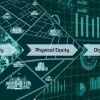
One of the challenges while working towards these goals is identifying appropriate social metrics that can be used to track progress, identify gaps, drive actionable insights, and at the same time provide a standard way to benchmark and compare status across regions and nations. A standard way of benchmarking allows for transparency in policy and directed investments that can have the maximum impact on the most vulnerable populations. Once the investment is made, the same metrics can now quantify the impact and the return on investment.
Different methods have been used to measure and compare SDG performance at the country level. These methods primarily use one of three different data models – a weighted average of all the indicators for which data is available, a distance based model, or a progress based model. It has been shown that there are strong discrepancies between these methods and countries can receive substantially different relative evaluations depending on the model chosen [1]. These discrepancies are a result of the lack of established standards on a number of the SDG indicators. Even where standards exist, availability and the currency of data is an issue. These models also fail to provide actionable insights that can specifically highlight regional gaps and where and what investments might have the most impacts.
Our goal was to evaluate a simplified data model that uses a facility-based data collection [2] to baseline status, and to create a process for continuous monitoring of progress (or lack thereof). The SDGs are highly correlated and modeling the data and dynamics between them correctly can provide insights into what can work across regions and countries. We show that a facility-based data collection can provide a simple and effective model to create a baseline for SDGs and a process for periodic data collection can measure and track progress towards the goals. Data at regional levels can be aggregated at country levels to measure a country’s progress towards the goals.
Under the Cities COVID Mitigation Management (C2M2) project of the US State Department, facility data was collected in the city of Kericho, Kenya. Health and education related facilities were enumerated and a team of data collectors visited each of these facilities. Information was collected regarding service capacity, service availability, and service reliability. The survey included questions about access to power, access to water and sanitation, and the gender mix of employees. The collected data was ingested into the Hawkai Data platform and a baseline created for UN SDG 3 (Health for All) and UN SDG 4 (Education for All). The supplementary data was used to create additional insights into the status of SDG 5 (Gender Equity), SDG 6 (Water and Sanitation), and SDG 7 (Access to Power).
Facility-Based Data
Facility-based data collection involves enumerating the facilities of interest, visiting the facility, and collecting data on service availability, service capacity, and service readiness. To establish a baseline for SDG 3 (Health for All) and SDG 4 (Education for All), data about the presence and distribution of health and educational facilities and the capacity and availability of services was collected. For health facilities, data was collected about health services offered, and capacity in terms of beds, doctors, nurses, etc. For educational facilities, questions were asked about online options, and the number of classrooms, teachers, students, etc.
The table below illustrates the facilities that were surveyed and the data that was collected to measure service availability, service capacity, and service readiness.
| UN SDG | Facility Type | Service Availability | Service Capacity | Service Readiness |
| SDG 3 Good Health and Well-Being | Dentist, Diagnostic Lab, Hospital, Medical Clinic, Pharmacy, Veterinary Care | Services offered, Opening Hours | Number of beds, Number of doctors, Number of nurses | Power Reliability, Primary water source |
| SDG 4 Education for All | Primary School, Secondary School, High School, Vocational, University | Online options | Number of classrooms, Number of teachers, Number of students | Power Reliability, Primary water source |
The data was collected in the city of Kericho, Kenya. Working with education and healthcare facilities to gather geospatial data was a challenging undertaking. In this context, the collaboration with the state services in charge of education and health was very beneficial for a smooth project execution. The table below shows the specific facilities that were surveyed and the percentage coverage for each type of facility. The coverage is low as the surveys were conducted while COVID restrictions were in-place and had to completed under compressed timelines.
| Facility Type | Total (in Kericho) | Number Surveyed | % Coverage |
| Pharmacy | 80 | 5 | 6% |
| Hospital/Clinic | 50 | 11 | 22% |
| Colleges/Schools | 15 | 2 | 13% |
To compare data and statistics across regions, the collected data has to be normalized to adjust for populations and demographic variables. The normalized data and statistics provide a baseline for the region. This baseline when compared with the desired SDG targets can be used to measure the distance to targets and where and what kind of investments are needed to achieve the desired targets.
The table below illustrates desired target metrics that are key aspirational indicators for the specific goals. The targets are derived from data maintained by the World Bank on workforce statistics (https://data.worldbank.org/indicator). These targets really depend on geographical contexts. It may be more appropriate to classify countries by socio/geographical context and assign targets by country groups. More research needs to be done and agreement reached on the appropriate targets for a country.
| UN SDG | Desired Outcome | Key Indicator | Desired Target |
| SDG 3 | Improve care capacity | Medical facilities per 100000, Doctors per 1000 population, Beds per 1000 population | 4 facilities per 100000, 3 Doctors per 1000, 4 Nurses per 1000, 5 Beds per 1000 |
| SDG 4 | Improve access to education | Teachers per 1000 students | 10 teachers per 1000 |
| SDG 5 | Gender equality among doctors, nurses, teachers | Female to Male ratio among doctors | Match local gender mix |
| SDG 6 | Access to safe water | Distribution of safe/unsafe water sources | Safe access to water for all |
| SDG 7 | Stable access to power | Access to stable power | Access to stable power for all |
SDG Dashboards
Once the data was ingested into the Hawkai Data platform, self-serve dashboards were used to provide analytical insights that allow for the tracking of a region’s SDG progress.
SDG 3 (Health for All) Dashboard
The Health Dashboard provides at-a-glance aggregated data on health resources available to a region. This data when combined with the demographic data provides a baseline for SDG 3 that can be used to track progress and distance to target.

According to the 2019 census, Kericho county has a population of 901,777. Using the 2019 census data as the base, the health metrics are shown in the table below. Kericho county has 0.5 doctors per 1000 of the population. The 2030 SDG target is 3 doctors per 1000 of population. These baseline metrics provide a score that can be compared across regions and the distance to the desired targets to be achieved by the year 2030.
| Total in facilities surveyed | Total in county extrapolated | Kericho County (Baseline metrics) | 2030 SDG Target | |
| Doctors | 99 | 450 | 0.5 | 3 |
| Nurses | 239 | 1086 | 1.2 | 4 |
The map below shows the distribution of the health facilities color-coded to show the type of the facility.

SDG 4 (Education for All) Dashboard
The SDG 4 (Education) Dashboard provides aggregated data on educational resources available within a region. This data when combined with the demographic data provides a baseline for SDG 4 that can be used to track progress towards the goal.

The 2030 SDG target is 10 teachers per 1000 of population. These baseline metrics provide a score that can be compared across regions and the distance to the desired targets to be achieved by 2030.

SDG 5 (Gender Equity) Dashboard
For each facility, gender statistic data was collected. For health facilities, data was collected on the number of male and female doctors and nurses. For educational facilities, similar data was collected on male and female teachers and students. This data was used to provide regional gender statistics in health care and educational professions and to understand gender imbalances in these professions.

SDG 6 (Water and Sanitation) Dashboard
Data was collected from the facilities to get a measure of the population that has access to safe drinking water and good sanitation. The form listed 12 options as the primary water source. These options allowed us to estimate the percentage of the population that has access to piped water connections, improved drinking water sources, and unimproved drinking water sources.

The facilities were asked to pick one of the options below to categorize their primary access to sanitation (https://www.cdc.gov/healthywater/global/assessing.html). The SDG target calls for improved sanitation facilities for all by the year 2030.

SDG 7 (Energy for All) Dashboard
Data was collected to get a measure of the population that has access to electricity (SDG 7). The tiers are a simplification of the World Bank’s Multi-Tier Framework for energy access (https://mtfenergyaccess.esmap.org/methodology/electricity).

Community Services
A facility registry for a city provides data and insights to local officials and the tools to measure, manage, and respond to the needs of the local populations. The collected data can be used to create services for city residents who can access it on their mobile phones. The Cities Navigator app makes it easy for users to find facilities of interest, check resource availability, and communicate with the facility. These capabilities illustrate the importance of geospatial data to facilitate access to care in under-examined locations. Using built-in dashboards, officials can track application usage and access metrics on service quality that will enable them to initiate policies to improve the quality of life of the local population. Sample metrics include i.e., number of doctors in the city, number of beds, number of ICU beds etc.

Local data skills, data quality, data integrity, and up-to-date data will determine the success of the apps and their continued usage. Citizen adoption of these apps and services will increase social equity and reduce the impact of any future pandemics, disasters, conflicts, and climate-change events. The role of local governments is critical for the success of such applications in low and middle income countries as it provides legitimation for the application.
Scaling the Pilot
The Kericho pilot was a demonstrator for how the facility-based data model can be used to create a regional baseline for SDG status and how a continuous process of data collection can track progress towards these goals. Data quality and integrity will determine the success of the dashboards, analytics, the Cities Navigator app and their continued usage. This requires the collected data to be complete, consistent, correct, and current.
- Complete – Completeness is about the data being comprehensive. Are all the facilities of interest in the area of interest recorded and accounted for? Are all the required fields filled?
- Consistent – Consistency is about assuring that different data collectors represent data in the same way and in the same formats. If an image is taken, are all images taken consistently in landscape mode? If a telephone number is required, is all data recorded with the country and area code included? Are there duplicate listings? Are all addresses entered consistently?
- Correct – Correctness is about accuracy of the information. Does the latitude/longitude accurately locate the facility?
- Current – Currency of data has to do with timeliness. Is the data provided current as to when the data was recorded? Currency becomes important when data is collected on a periodic basis.
The facility-based data model provides a simple and sustainable process that countries can use to measure SDG progress and also use to quantify the impact of social programs and investments. The Kericho pilot when scaled to include all counties in a country will provide key insights, identify regional gaps and vulnerable populations, and enable focused social investments that can have the most impact. In addition, facility registries can be used to create mobile apps that users can use to find facilities of interest, check resource availability, and communicate with the facility.
Acknowledgements
This research was possible thanks to the Cities’ Covid Mitigation Mapping (C2M2) program, developed by the U. S. Department of State’s Humanitarian Information Unit and the American Association of Geographers (AAG). The pilot was done jointly with our partners UASG Advisors and DDD.
UASG Advisors focuses on process improvement and digital transformation to drive organizational efficiencies. Since 2017, UASG Advisors has provided strategic leadership and project oversight for US State Department funded projects in Africa. UASG Advisors set up the Africa Hub for the US State Department, established local partnerships and setup the process for geospatial data gathering and analysis across multiple countries in Africa.
Digital Divide Data (DDD) is a non-profit social enterprise that provides outsourced data collection, data preparation, and digitization services. DDD has teams across 9 countries with the ability to scale operations across multiple locations and countries. DDD clients include Fortune 100 companies, category market leaders and NGOs.
References
[1] Apollonia Miola, Fritz Schiltz, Measuring sustainable development goals performance: How to monitor policy action in the 2030 Agenda implementation?, Ecological Economics, Volume 164, 2019, 106373, ISSN 0921-8009, https://doi.org/10.1016/j.ecolecon.2019.106373.
[2] Gaston Mbonglou, Ranjit John. Data and dashboards for measuring the social impact of COVID-19 in African cities. The Geographies of COVID-19 — Geospatial Stories of the Global COVID-19 Pandemic. Springer;2022;Chapter 11.








